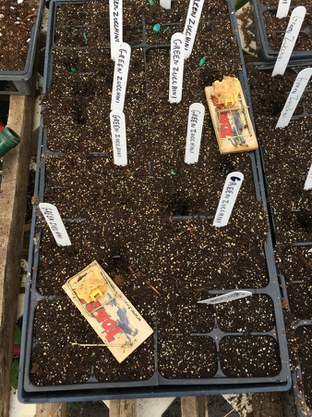Jun 15, 2016There’s a mouse in the (green)house
Exposed, chewed or missing seeds in greenhouse trays are signs of mouse activity. Snap traps are an effective control measure for mice and voles if populations aren’t too large.
Here in Pennsylvania the predominant species found in greenhouses are the white footed mouse and the closely related deer mouse. Both are in the genus Peromyscus, and should not be confused with the house mouse, Mus musculus.
White footed and deer mice have white feet, a white underside and brown upper surface. Their eyes and ears are relatively large, and their tails are long. Mice are mostly nocturnal. Adapted to outdoor conditions, these mice feed primarily on seeds, berries and nuts. In fact, research has shown that they will consume a significant number of weed seeds in crop fields. However, in greenhouses, they will uncover and feed on seeds and very small seedlings in greenhouse pots and trays.
Voles chew leaves, stems, roots and tubers
Voles are the other rodent commonly found in greenhouses. Members of the genus Microtus, voles suffer a bit of an identity crisis as they are frequently confused with mice, moles and shrews. In Pennsylvania, the most common are the meadow vole and the woodland or pine vole. Unlike moles and shrews, voles have rounded, blunt snouts and chisel-shaped front teeth, and their eyes and ears are readily apparent, although they are smaller than those on a mouse. Voles have shorter tails than mice, and no white coloring on their undersides.
Voles prefer grassy areas where they construct their extensive tunnels and runs, but they will also thrive among pots and flats in a greenhouse. They are most active in early morning and late afternoons. Voles feed on shoots of young plants as well as on roots, bulbs, tubers and rhizomes. They can be particularly problematic in overwintered perennials and other nursery stock, causing damage by their direct feeding as well as their chewing and tunneling through pots and flats.
Controlling mice and voles in the greenhouse
- Monitor for mice and vole activity before populations build to levels difficult to control.
- Tighten up the greenhouse to limit entryways. Note that mice can squeeze through holes as small at 1/4 inch. Small mesh hardware cloth can be placed around the outside of the greenhouse perimeter, with the bottom edge buried in the ground and bent away from the structure. Keep grass and other vegetation away from greenhouse perimeters.
- Snap traps baited with peanut butter (mice and voles), oatmeal (mice) or apple (voles) can be effective for small populations. Repellents have not been shown to be consistently effective.
- Toxic baits can be very effective, but must be deployed carefully in order to protect other animals and even children. Anticoagulant baits can be purchased off the shelf, but multiple feedings are usually required. Single dose baits with zinc phosphide as the active ingredient are restricted use materials and must be purchased and used by a certified pesticide applicator. Follow all label directions and precautions when using bait traps.
Source: Penn State Extension
– Lee Stivers, Penn State Extension















